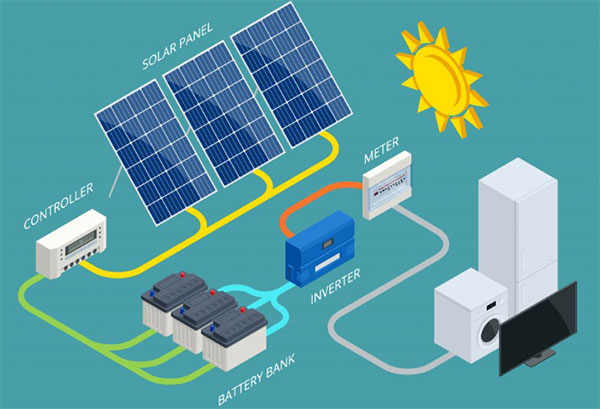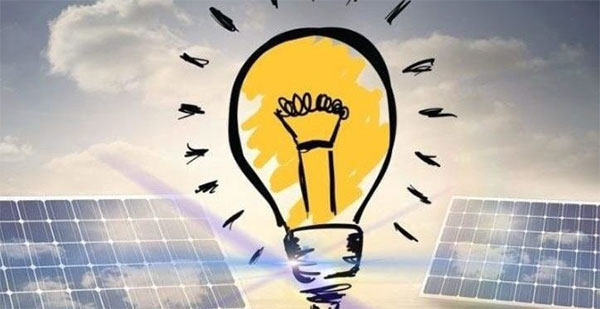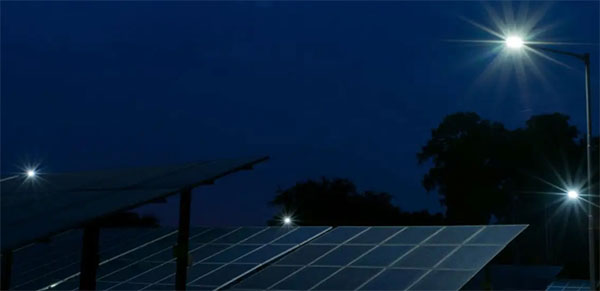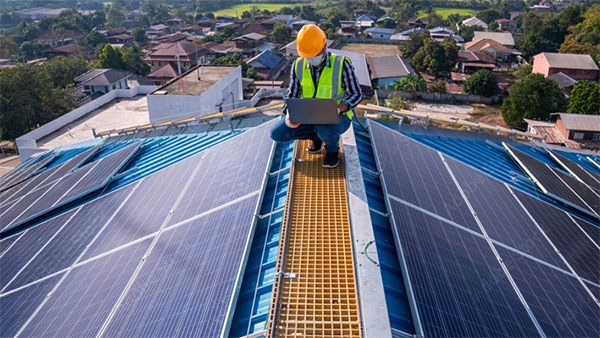
Solar Panels Without Sunlight
Solar panels primarily rely on sunlight to generate electricity, but they can still function under less than ideal lighting conditions. The efficiency and energy output, however, are significantly affected by the availability and intensity of light.
Can Solar Panels Function in Cloudy Weather?
In cloudy weather, solar panels can still operate, but their efficiency decreases. The amount of sunlight reaching the panels is less due to cloud cover, resulting in reduced power output. On average, solar panels can produce about 10% to 25% of their rated capacity under heavy cloud cover.
- Reduced Light Intensity: Clouds scatter and diffuse sunlight, leading to a decrease in the intensity of light that reaches the solar panels.
- Energy Output: The energy output in cloudy conditions depends on the thickness of the cloud cover and the type of solar panel. Some modern panels are better at capturing diffused sunlight.
- Efficiency Drop: On cloudy days, the efficiency of solar panels typically drops, but they do not stop producing electricity altogether.
Solar Panels at Night: Possibilities and Limitations
Solar panels do not produce electricity at night as they require sunlight to trigger the photovoltaic effect. However, solar energy storage systems can store energy produced during the day for use at night.
- No Sunlight, No Power: Without sunlight, solar panels cannot generate power. Their effectiveness is zero during nighttime.
- Energy Storage Solutions: To provide electricity at night, solar systems are often paired with battery storage systems. This allows for the storage of excess energy generated during the day.
- Grid Connection: In grid-tied solar panel systems, the grid can supply electricity at night, and excess solar energy can be fed back to the grid during the day in exchange for credits.
The cost of adding a battery storage system to a solar panel setup varies, but it typically ranges from $5,000 to $7,000 for a battery capable of storing enough energy to power an average home overnight. This additional investment can increase the overall cost of a solar installation, but it also enhances its utility by providing a continuous power supply.
For further details on how solar panels work and their capabilities in various light conditions, the
Wikipedia page on Photovoltaics offers comprehensive information.
Alternative Sources of Light
Solar panels primarily utilize sunlight for electricity generation, but they can also work with alternative light sources. The effectiveness of these alternative sources varies based on their properties and intensity.
Artificial Light and Solar Panels
Solar panels can generate electricity from artificial light sources such as LEDs and fluorescent bulbs. The efficiency of electricity generation with artificial light depends on the intensity and spectrum of the light source.
- LEDs: These are effective for use with solar panels due to their high intensity and specific light spectrum. However, the power output is significantly lower compared to direct sunlight.
- Fluorescent Bulbs: Similar to LEDs, fluorescent bulbs can power solar panels but at a lower efficiency.
- Incandescent Bulbs: These are less efficient for solar panels due to their broad spectrum and lower light intensity.
Comparing Sunlight with Other Light Sources
| Light Source |
Efficiency with Solar Panels |
Average Power Output |
Cost-Effectiveness |
| Sunlight |
High (15% - 20%) |
250 - 400 watts/panel |
Highly cost-effective |
| LEDs |
Moderate (depends on LED) |
Significantly lower than sunlight |
Less cost-effective |
| Fluorescent |
Low to Moderate |
Lower than sunlight |
Not cost-effective |
| Incandescent |
Very Low |
Minimal |
Not cost-effective |
While solar panels can technically generate electricity from these sources, the efficiency and cost-effectiveness vary greatly. Sunlight remains the most viable source for solar energy production. Artificial lights, due to their lower intensity and different spectral outputs, are less efficient and not practical for large-scale electricity generation.
For more comprehensive information on solar panels and their interaction with various light sources, the
Wikipedia page on Solar Energy provides valuable insights.

Improving Solar Panel Efficiency
Improving the efficiency of solar panels involves enhancing their ability to convert sunlight into electricity. Advances in materials and design play a crucial role in this process.
Innovations in Low-Light Solar Technology
Recent technological advancements aim to increase the efficiency of solar panels, especially in low-light conditions:
- Bifacial Solar Panels: Capture light from both sides, increasing total energy yield.
- Thin-Film Technology: Offers better performance in low-light conditions compared to traditional silicon cells.
- Quantum Dots: Nanotechnology that enhances the light absorption spectrum of solar cells.
Tips for Maximizing Solar Panel Performance in Low-Light Conditions
To optimize solar panel performance, even in low-light, certain strategies can be employed:
- Regular Cleaning: Ensure panels are free of dust and debris to maximize light absorption.
- Optimal Angle and Positioning: Adjust the angle and position to capture the maximum available light.
- Use of Reflectors: Reflectors can direct additional light onto the panels.
Here is a comparison of traditional and advanced solar panel technologies:
| Technology Type |
Efficiency in Low-Light |
Cost |
Lifespan |
Advantages |
| Standard Silicon Panels |
Moderate |
Lower |
25-30 years |
Widely available, proven technology |
| Bifacial Panels |
High |
Higher |
30+ years |
Increased energy yield, efficient in varying light conditions |
| Thin-Film Panels |
High in low light |
Moderate |
20-25 years |
Flexible, performs well in low light |
| Quantum Dot Solar Cells |
Very High |
Currently Expensive |
Under research |
High potential in efficiency, cutting-edge technology |
Each technology offers unique benefits and drawbacks. Standard silicon panels are cost-effective and widely used but less efficient in low-light conditions. Bifacial panels and thin-film technology provide better performance in varying light conditions but come with higher costs and different lifespan considerations. Quantum dot solar cells represent an emerging technology with the potential for high efficiency, although they are still in the development stage and more expensive.

Case Studies
Analyzing real-world examples helps in understanding how solar panels perform in different environmental conditions. This section focuses on solar panel applications in northern regions with limited sunlight and in areas with challenging weather.
Solar Panels in Northern Regions with Limited Sunlight
In regions like Scandinavia or Northern Canada, solar panels encounter unique challenges due to the limited sunlight, particularly during the winter months.
- Extended Daylight in Summer: These regions experience long daylight hours in summer, which solar panels can capitalize on.
- Low Sun Angle: The sun stays low on the horizon, reducing the intensity of sunlight. Solar panels in these areas often use specialized designs and positioning to maximize light capture.
- Cold Weather Efficiency: Solar panels are more efficient at colder temperatures, which can partly compensate for reduced sunlight.
Tongwei Solar Panels: A recommendation for such regions is the Tongwei solar panel range. These panels are known for their high efficiency in low-light conditions. They feature advanced cell technology that allows for better performance even during overcast days or when the sun is at a low angle.
| Feature of Tongwei Panels |
Details |
| Efficiency |
High, with advanced cell technology suitable for low-light conditions |
| Durability |
Designed to withstand harsh weather, including heavy snow and cold temperatures |
| Cost-Effectiveness |
Competitive pricing, offering a good balance between initial investment and long-term energy yield |
| Lifespan |
Extended lifespan due to robust construction and quality materials |
Solar Energy in Weather-Challenged Areas
Areas with frequent cloudy, rainy, or stormy weather present additional challenges for solar panel deployment.
- Cloud Tolerance: Modern solar panels, like those from Tongwei , are better equipped to handle low-light conditions caused by cloudy weather.
- Storm Resistance: Solar panels in these areas are often built to be more robust, able to withstand high winds and heavy rains.
- Energy Storage: Integrating energy storage solutions is crucial in these areas to ensure a consistent energy supply, especially during prolonged periods of poor weather.
Solar panels in challenging weather conditions must balance efficiency, durability, and cost to provide a viable energy solution. Innovations in solar technology, including those by Tongwei , are making solar energy more feasible and efficient in these environments.
For additional information on solar energy applications in various geographical and climatic conditions, resources like the
Solar Energy page on Wikipedia offer extensive insights.







